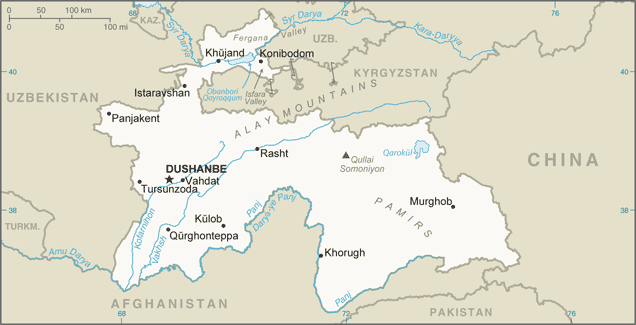Tajikistan
 Aglow Status:
Aglow Status:
No Aglow presence
Capital: Dushanbe
Pray:
- We are praying for Aglow to be affiliated in every nation in the world. We are very close to reaching that goal. Let’s continue to move forward together, an army in the Spirit, to see Every nation touched, every heart changed.
- Pray that an Aglow Prayer Group will be established in the capital city.
- Pray for many to arise in Aglow International in Tajikistan.
Proclaim:
- Arise, shine; for your light has come! And the glory of the LORD is risen upon you. For behold, the darkness shall cover the earth, and deep darkness the people; but the LORD will arise over you, and His glory will be seen upon you. Isaiah 60:1, 2 (NKJV)
- Lift up your heads, O you gates! Lift up, you everlasting doors! And the King of glory shall come in. Who is this King of glory? The Lord of hosts, He is the King of glory. Selah Psalm 24:9-10 (NKJV)
Interesting Facts About Tajikistan
The Tajik people came under Russian imperial rule in the 1860s and 1870s, but Russia’s hold on Central Asia weakened following the Revolution of 1917. At that time, bands of indigenous guerrillas (called “basmachi”) fiercely contested Bolshevik control of the area, which was not fully reestablished until 1925. Tajikistan was first created as an autonomous republic within Uzbekistan in 1924, but in 1929 the USSR designated Tajikistan a separate republic and transferred to it much of present-day Sughd province. Ethnic Uzbeks form a substantial minority in Tajikistan, and ethnic Tajiks an even larger minority in Uzbekistan. Tajikistan became independent in 1991 following the breakup of the Soviet Union, and experienced a civil war between political, regional, and religious factions from 1992 to 1997.
Though the country holds general elections for both the presidency (once every seven years) and parliament (once every five years), observers note an electoral system rife with irregularities and abuse, with results that are neither free nor fair. President Emomali RAHMON, who came to power in 1994 during the civil war, used an attack planned by a disaffected deputy defense minister in 2015 to ban the last major opposition political party in Tajikistan. In December 2015, RAHMON further strengthened his position by having himself declared “Founder of Peace and National Unity, Leader of the Nation,” with limitless terms and lifelong immunity through constitutional amendments ratified in a referendum. The referendum also lowered the minimum age required to run for president from 35 to 30, which would make RAHMON’s son Rustam EMOMALI, the current mayor of the capital city of Dushanbe, eligible to run for president in 2020.
The country remains the poorest in the former Soviet sphere. Tajikistan became a member of the WTO in March 2013. However, its economy continues to face major challenges, including dependence on remittances from Tajikistani migrant laborers working in Russia and Kazakhstan, pervasive corruption, and the opiate trade and other destabilizing violence emanating from neighboring Afghanistan. Tajikistan has endured several domestic security incidents since 2010, including armed conflict between government forces and local strongmen in the Rasht Valley and between government forces and criminal groups in Gorno-Badakhshan Autonomous Oblast. Tajikistan suffered its first ISIS-claimed attack in 2018, when assailants attacked a group of Western bicyclists with vehicles and knives, killing four.
Government Type: presidential republic
Population: 8,990,874 (July 2021 est.)
Ethnic Groups: Tajik 84.3% (includes Pamiri and Yagnobi), Uzbek 13.8%, other 2% (includes Kyrgyz, Russian, Turkmen, Tatar, Arab) (2014 est.)
Languages: Tajik (official) 84.4%, Uzbek 11.9%, Kyrgyz .8%, Russian .5%, other 2.4% (2010 est.)
Religions: Muslim 98% (Sunni 95%, Shia 3%) other 2% (2014 est.)
Interesting Facts information from the cia.gov website. Read more about Tajikistan

